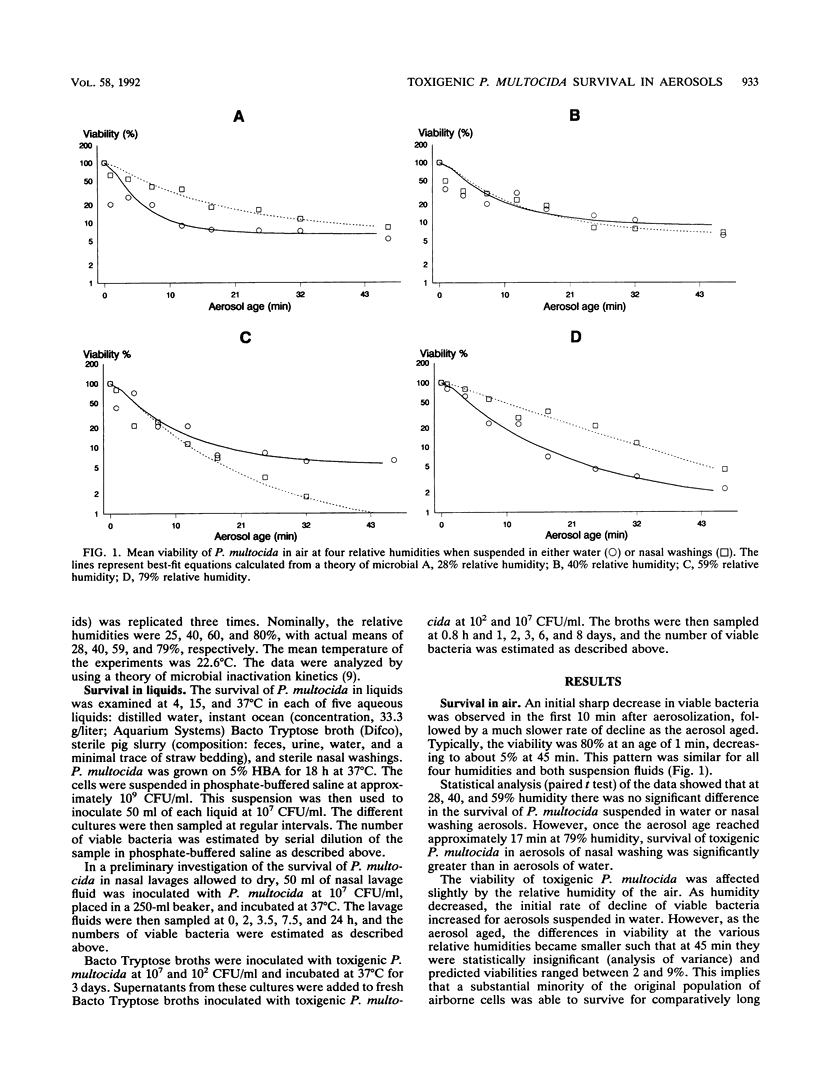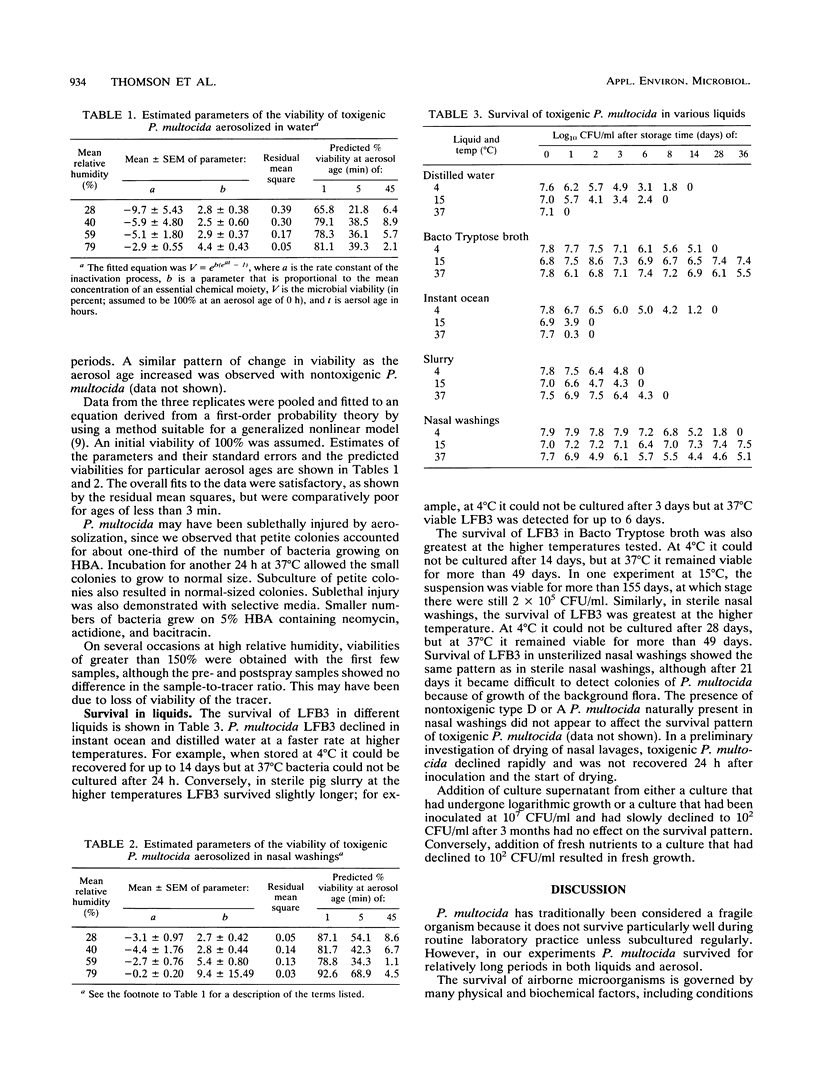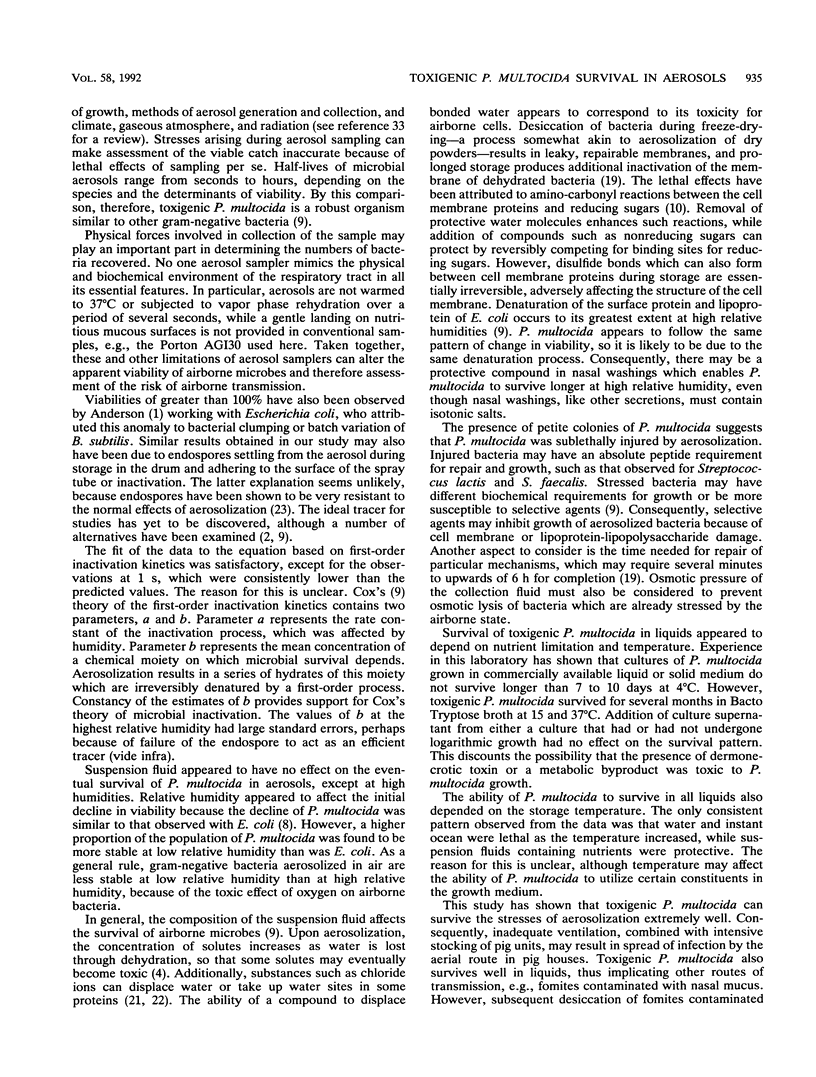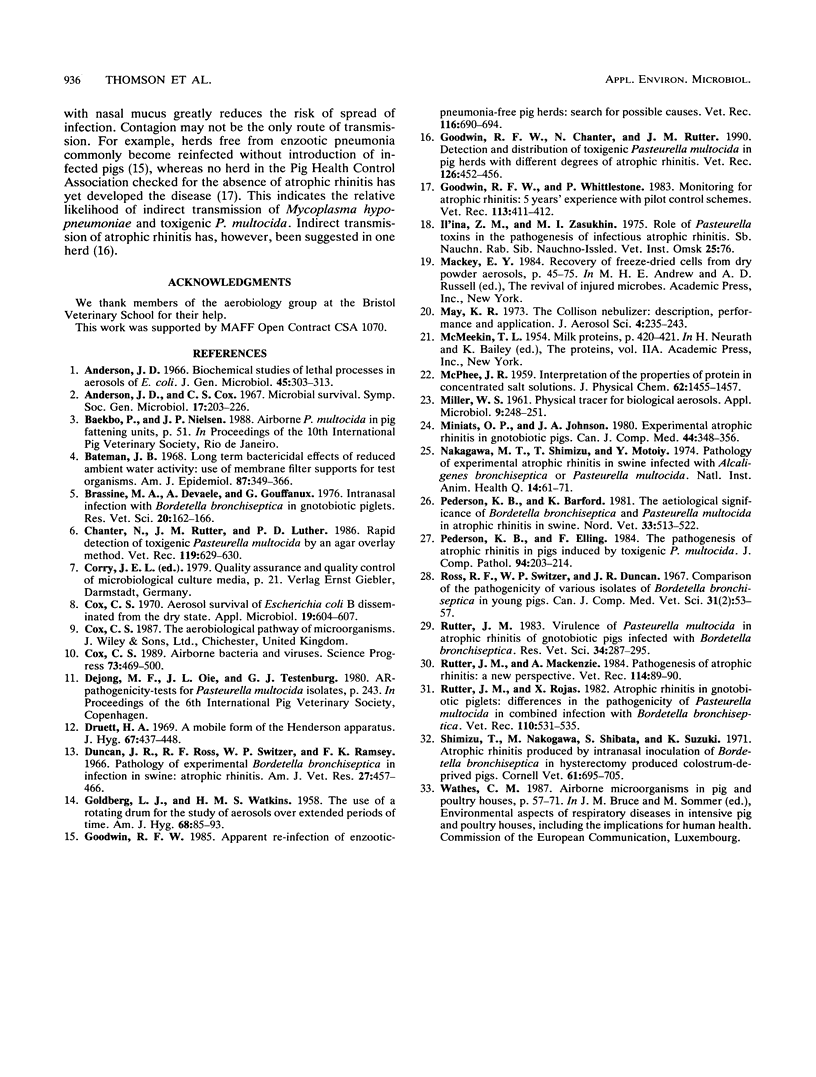Abstract
The survival of toxigenic Pasteurella multocida in air and liquids was studied to identify possible risk factors in the etiology of atrophic rhinitis. In aerosols, at low relative humidity (28%), the viability of toxigenic P. multocida 5 min after aerosolization was at least 22% of its initial value. Viability at low relative humidity declined to 8% after 45 min. Viability at high relative humidity (79%) was 69% after 5 min and declined to 2% after 45 min. Survival of toxigenic P. multocida in liquids depended on storage and constituents in the liquid. Toxigenic P. multocida became nonculturable 1 to 14 days after inoculation in water and artificial seawater, depending on the storage temperature. Toxigenic P. multocida stored at 37 degrees C could be detected for up to 6 days in pig slurry and more than 36 days in Bacto Tryptose broth and nasal lavages. However, in Bacto Tryptose broth and nasal lavages stored at 4 degrees C, P. multocida was detected for up to 14 days whereas at 15 and 37 degrees C it was detected for more than 49 days. These results suggest that aerosols and fomites can play a role in the transmission of atrophic rhinitis.
Full text
PDF




Selected References
These references are in PubMed. This may not be the complete list of references from this article.
- Anderson J. D. Biochemical studies of lethal processes in aerosols of Escherichia coli. J Gen Microbiol. 1966 Nov;45(2):303–313. doi: 10.1099/00221287-45-2-303. [DOI] [PubMed] [Google Scholar]
- Bateman J. B. Long-term bactericidal effects of reduced ambient water activity: use of membrane filter support for test organisms. Am J Epidemiol. 1968 Mar;87(2):349–366. doi: 10.1093/oxfordjournals.aje.a120826. [DOI] [PubMed] [Google Scholar]
- Brassinne M., Dewaele A., Gouffaux M. Intranasal infection with Bordetella bronchiseptica in gnotobiotic piglets. Res Vet Sci. 1976 Mar;20(2):162–166. [PubMed] [Google Scholar]
- Chanter N., Rutter J. M., Luther P. D. Rapid detection of toxigenic Pasteurella multocida by an agar overlay method. Vet Rec. 1986 Dec 20;119(25-26):629–630. [PubMed] [Google Scholar]
- Cox C. S. Aerosol survival of Escherichia coli B disseminated from the dry state. Appl Microbiol. 1970 Apr;19(4):604–607. doi: 10.1128/am.19.4.604-607.1970. [DOI] [PMC free article] [PubMed] [Google Scholar]
- Cox C. S. Airborne bacteria and viruses. Sci Prog. 1989;73(292 Pt 4):469–499. [PubMed] [Google Scholar]
- Druett H. A. A mobile form of the Henderson apparatus. J Hyg (Lond) 1969 Sep;67(3):437–448. doi: 10.1017/s0022172400041851. [DOI] [PMC free article] [PubMed] [Google Scholar]
- Duncan J. R., Ross R. F., Switzer W. P., Ramsey F. K. Pathology of experimental Bordetella bronchiseptica infection in swine: atrophic rhinitis. Am J Vet Res. 1966 Mar;27(117):457–466. [PubMed] [Google Scholar]
- GOLDBERG L. J., WATKINS H. M., BOERKE E. E., CHATIGNY M. A. The use of a rotating drum for the study of aerosols over extended periods of time. Am J Hyg. 1958 Jul;68(1):85–93. doi: 10.1093/oxfordjournals.aje.a119954. [DOI] [PubMed] [Google Scholar]
- Goodwin R. F. Apparent reinfection of enzootic-pneumonia-free pig herds: search for possible causes. Vet Rec. 1985 Jun 29;116(26):690–694. doi: 10.1136/vr.116.26.690. [DOI] [PubMed] [Google Scholar]
- Goodwin R. F., Chanter N., Rutter J. M. Detection and distribution of toxigenic Pasteurella multocida in pig herds with different degrees of atrophic rhinitis. Vet Rec. 1990 May 5;126(18):452–456. [PubMed] [Google Scholar]
- Goodwin R. F., Whittlestone P. Monitoring for atrophic rhinitis: five years' experience with a pilot control scheme. Vet Rec. 1983 Oct 29;113(18):411–412. doi: 10.1136/vr.113.18.411. [DOI] [PubMed] [Google Scholar]
- MILLER W. S., SCHERFF R. A., PIEPOLI C. R., IDOINE L. S. Physical tracers for bacterial aerosols. Appl Microbiol. 1961 May;9:248–251. doi: 10.1128/am.9.3.248-251.1961. [DOI] [PMC free article] [PubMed] [Google Scholar]
- Mackey B. M. Lethal and sublethal effects of refrigeration, freezing and freeze-drying on micro-organisms. Soc Appl Bacteriol Symp Ser. 1984;(12):45–75. [PubMed] [Google Scholar]
- Nakagawa M., Shimizu T., Motoi Y. Pathology of experimental atrophic rhinitis in swine infected with Alcaligenes bronchisepticus or Pasteurella multocida. Natl Inst Anim Health Q (Tokyo) 1974 Summer;14(2):61–71. [PubMed] [Google Scholar]
- Pedersen K. B., Elling F. The pathogenesis of atrophic rhinitis in pigs induced by toxigenic Pasteurella multocida. J Comp Pathol. 1984 Apr;94(2):203–214. doi: 10.1016/0021-9975(84)90041-0. [DOI] [PubMed] [Google Scholar]
- Ross R. F., Switzer W. P., Duncan J. R. Comparison of pathogenicity of various isolates of Bordetella bronchiseptica in young pigs. Can J Comp Med Vet Sci. 1967 Feb;31(2):53–57. [PMC free article] [PubMed] [Google Scholar]
- Rutter J. M., Mackenzie A. Pathogenesis of atrophic rhinitis in pigs: a new perspective. Vet Rec. 1984 Jan 28;114(4):89–90. doi: 10.1136/vr.114.4.89. [DOI] [PubMed] [Google Scholar]
- Rutter J. M. Virulence of Pasteurella multocida in atrophic rhinitis of gnotobiotic pigs infected with Bordetella bronchiseptica. Res Vet Sci. 1983 May;34(3):287–295. [PubMed] [Google Scholar]
- Shimizu T., Nakagawa M., Shibata S., Suzuki K. Atrophic rhinitis produced by intranasal inoculation of Bordetella bronchiseptica in hysterectomy produced colostrum-deprived pigs. Cornell Vet. 1971 Oct;61(4):696–705. [PubMed] [Google Scholar]


